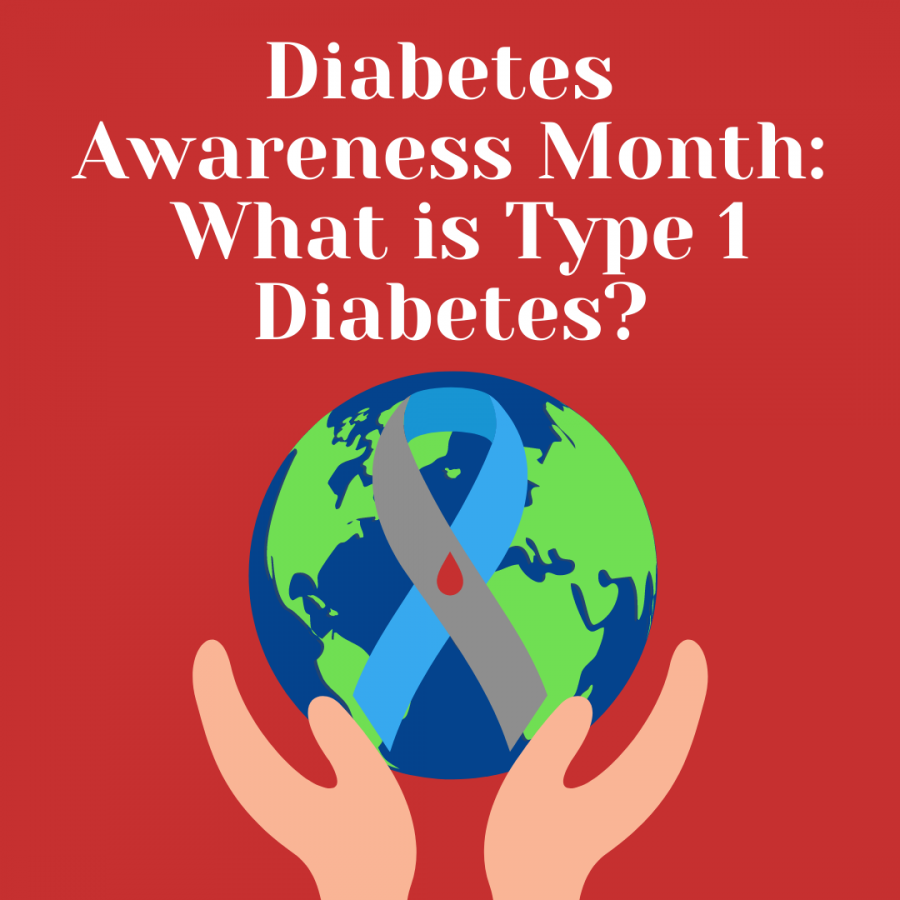Diabetes Awareness Month: What is Type 1 Diabetes?
November 21, 2021
November marks Diabetes Awareness Month. Throughout the month, people all around the world team up to spread awareness of Type 1 Diabetes and highlight the need for a cure. So, what exactly is Type 1 Diabetes?
Type 1 Diabetes, also known as juvenile diabetes, is an autoimmune disorder in which the pancreas produces little to no insulin, an important hormone that allows glucose to enter cells and produce energy. The disorder mainly affects children and adults, but individuals can be diagnosed at any age.
Researchers do not know exactly what causes Type 1 Diabetes, but they do know specific triggers and factors that can contribute to a diagnosis, such as genetics. Similar to any other disorder or disease, having a family history of Type 1 Diabetes puts individuals at higher risk of a diagnosis. Despite this, a majority of Type 1 Diabetes diagnoses occur in people with no family history of the disease.

Viral infections can also trigger Type 1 Diabetes. Researchers believe that certain viral infections could cause an adverse reaction in the body, causing the pancreas to stop producing insulin; thus, one may develop Type 1 Diabetes.
Prior to a diagnosis, individuals may experience increased thirst, frequent urination, bed-wetting, hunger, fatigue and/or blurred vision. These symptoms differ from those of the other main type of diabetes: Type 2. Different from Type 1 Diabetes, people suffering from Type 2 Diabetes can produce insulin; however, the body cannot use it properly to produce glucose and energy. Type 2 Diabetes mainly affects middle age to older people, while Type 1 Diabetes mainly affects youth. According to the Juvenile Diabetes Research Foundation, Type 1 Diabetes affects about 5% of people in the United States. Because of the different types of diabetes, misconceptions persist.
After being diagnosed with Type 1 Diabetes, individuals must begin making drastic changes to their daily lifestyle. Since the body can no longer produce enough insulin, blood-sugar monitoring becomes extremely important for managing the disorder. Monitoring lets individuals know when insulin is needed to correct high or low blood sugar. With the rise of medical technology, devices such as continuous glucose monitors, or CGMs, provide an easy way to monitor blood sugar levels.
Alongside blood-sugar monitoring, individuals suffering from Type 1 Diabetes must begin counting carbohydrate intake. Because carbs break down as sugars in the body, carb counting allows individuals to manage their blood sugar more easily. Endocrinologists — doctors specializing in the endocrine system, which serves as the network of hormone-producing glands — work alongside individuals to create an insulin-to-carb ratio tailored to that individual’s needs. The ratio represents how much insulin is needed to balance one’s intake of carbs.
Currently, there is no cure for diabetes. To stay alive, individuals suffering from Type 1 Diabetes must administer insulin throughout the day. There are a variety of ways to do this from rapid-acting to short-acting to long-acting injections. The type of injection depends on the needs of the individual at the time. Administered in the buttocks, thigh, abdomen or arms, injections provide a quick dosage of insulin that can regulate blood sugar levels. Individuals may also wear pumps that deliver insulin throughout the day. Pumps can be worn on one’s hip, tricep, upper thigh, abdomen or other parts of the body that offer easy access.
In recent years, doctors and researchers have found innovative ways to treat diabetes. In 2016, the Food and Drug Administration approved the first artificial pancreas, a device that serves as an automated insulin delivery system. The development of this device marked a significant victory in the Type 1 Diabetes community. Living with this disease is extremely challenging and serious. However, the support from organizations across the world such as the Juvenile Diabetes Research Foundation provides resources for spreading awareness and finding a cure.
If interested in joining the fight to find a cure for diabetes, there are many ways to get involved. As the leading non-profit organization in juvenile diabetes research, JDRF provides opportunities for individuals to get involved with advocacy and fundraising efforts. By spreading awareness and supporting research, individuals can impact the fight to find a cure for Type 1 Diabetes and eliminate the suffering of over 1.5 million Americans.









